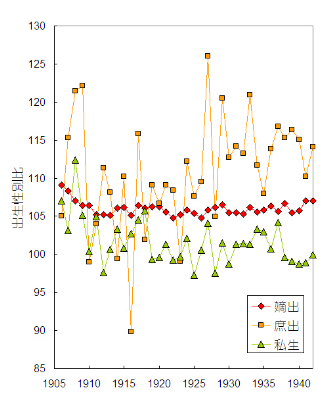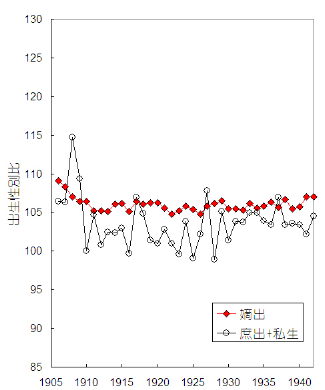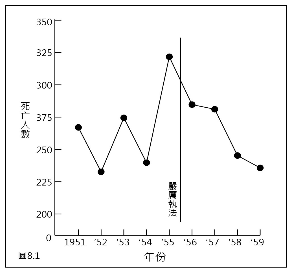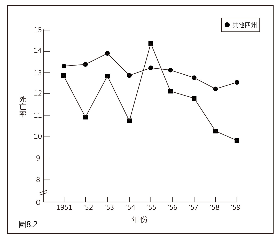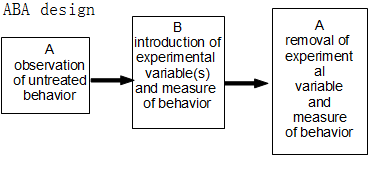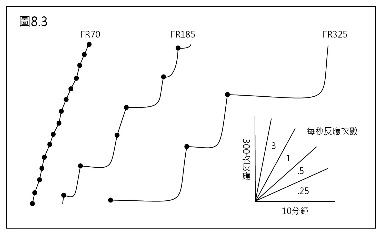心理實驗法第九講:其他實驗法
出自KMU Wiki
(修訂版本間差異)
| 在2007年11月8日 (四) 11:56所做的修訂版本 (編輯) Sakurai (對話 | 貢獻) (新頁面: 其他實驗法<br><br> == Quasi-Experimental design == * Campbell and Stanley (1966) ** ex post facto research * 兩種類型 ** interrupted time-series ** nonequivalent comparison g...) ←上一個 |
當前修訂版本 (2020年11月25日 (三) 13:49) (編輯) (撤銷) Sakurai (對話 | 貢獻) 小 (→第八講Case study 1) |
||
| (11個中途的修訂版本沒有顯示。) | |||
| 第1行: | 第1行: | ||
| 其他實驗法<br><br> | 其他實驗法<br><br> | ||
| - | == | + | == Trend analysis的例子 == |
| - | * | + | ** 取材自 地圖會說話([http://mapstalk.blogspot.tw/2009/10/blog-post.html 台灣歷史上有沒有殺女嬰現象?]) |
| - | ** | + | ** 問題是歷史上在台灣是否有過殺女嬰的現象? |
| - | * | + | ** 以及有的話嫡出子、庶子、私生子間有無不同? |
| - | ** | + | *** 嫡出子的母親是元配,庶子的母親是妾,私生子的雙親則沒有正式婚姻關係。 |
| - | ** | + | ** 男女嬰出生比105~106比100 |
| + | |||
| + | * 有殺女嬰! | ||
| + | [[Image:8-1.PNG]] | ||
| + | * 其實呢! | ||
| + | [[Image:8-2.PNG]] | ||
| === Closed vs Open system === | === Closed vs Open system === | ||
| 第18行: | 第23行: | ||
| ** macrocosmic life | ** macrocosmic life | ||
| - | === | + | === Quasi-Experimental design === |
| + | |||
| + | * Quasi-Experimental design(準實驗法) | ||
| + | * Campbell and Stanley (1966) | ||
| + | ** ex post facto research | ||
| + | * 兩種類型 | ||
| + | ** interrupted time-series | ||
| + | ** nonequivalent comparison group | ||
| + | |||
| + | === 第八講Case study 1 === | ||
| * 地點:Connecticut | * 地點:Connecticut | ||
| 第24行: | 第38行: | ||
| * 期間:1951-1959 | * 期間:1951-1959 | ||
| * 事件:harsh treatment of speeders in 1955 | * 事件:harsh treatment of speeders in 1955 | ||
| - | * | + | * 結果: |
| + | [[Image:8-3.PNG]] | ||
| * 可能影響交通事件的原因 | * 可能影響交通事件的原因 | ||
| ** 可能有: | ** 可能有: | ||
| 第42行: | 第57行: | ||
| ** 差不多 | ** 差不多 | ||
| ** '51~'55與'56~'59 | ** '51~'55與'56~'59 | ||
| - | ** | + | ** 前半段上升,'56後下降 |
| * 對照組 | * 對照組 | ||
| - | + | [[Image:8-4.PNG]] | |
| - | ** | + | ** 圓點是其他四個州的平均 |
| * 對照什麼? | * 對照什麼? | ||
| ** 全國性的因素—汽車性能等 | ** 全國性的因素—汽車性能等 | ||
| ** 不能對照什麼? | ** 不能對照什麼? | ||
| ** 地區性的因素—駕駛人習慣 | ** 地區性的因素—駕駛人習慣 | ||
| - | + | ||
| - | + | ||
| * Why quasi? | * Why quasi? | ||
| ** 接近open system | ** 接近open system | ||
| 第62行: | 第76行: | ||
| * 自行為學派至認知心理學 | * 自行為學派至認知心理學 | ||
| * 行為學派的起源 | * 行為學派的起源 | ||
| - | * | + | * 行為學派的功過 |
| * 認知心理學的誕生 | * 認知心理學的誕生 | ||
| * How to open the “black box” | * How to open the “black box” | ||
| 第78行: | 第92行: | ||
| ** 始於20世紀初、沒落於'60代 | ** 始於20世紀初、沒落於'60代 | ||
| - | + | == Functional design == | |
| * Skinnerians | * Skinnerians | ||
| 第86行: | 第100行: | ||
| ** Individual difference | ** Individual difference | ||
| ** Ineffective control | ** Ineffective control | ||
| + | [https://sites.google.com/site/tsaipaw/home 國內的 Skinnerian 蔡式淵 ] | ||
| * 與其他實驗間差異 | * 與其他實驗間差異 | ||
| ** Atheoretical | ** Atheoretical | ||
| - | ** Not testing theory | + | *** Not testing theory |
| - | ** Control behavior | + | *** Control behavior |
| - | + | ** Small n | |
| + | *** Observe one or two | ||
| + | *** Response curve<br> | ||
| - | * Observe one or two | ||
| - | ** Response curve<br> | ||
| * Small n design | * Small n design | ||
| - | ** | + | ** 使用少數(一或二)實驗參與者 |
| * ABA design | * ABA design | ||
| + | [[Image:8-5.PNG]] | ||
| ** Small n 的特性 | ** Small n 的特性 | ||
| * 第一個A的用途 | * 第一個A的用途 | ||
| ** Baseline之建立 | ** Baseline之建立 | ||
| - | + | *因果關係? | |
| - | + | ** Synergistic effect | |
| - | + | *** 引入變項時多種其他因素也隨之帶入 | |
| - | * Synergistic effect | + | *** 如:利用行為改變法減重 |
| - | ** 引入變項時多種其他因素也隨之帶入 | + | |
| - | ** 如:利用行為改變法減重 | + | |
| * Small n paradigm | * Small n paradigm | ||
| ** AAA design | ** AAA design | ||
| 第113行: | 第127行: | ||
| ** AB1AB2AB3A | ** AB1AB2AB3A | ||
| - | ==== | + | ==== 第八講 Case study 2 ==== |
| * Operant conditioning | * Operant conditioning | ||
| 第127行: | 第141行: | ||
| * Control: body weight 80% of ad lib feeding | * Control: body weight 80% of ad lib feeding | ||
| * Schedule: FR70(1 w)->FR185(1 w)->FR325(1 w)->FR325(1 w)->FR185(1 w)->FR70(1 w) | * Schedule: FR70(1 w)->FR185(1 w)->FR325(1 w)->FR325(1 w)->FR185(1 w)->FR70(1 w) | ||
| - | * Result: | + | * Result: |
| + | [[Image:8-6.PNG]] | ||
| * 結果的表示 | * 結果的表示 | ||
| ** p.70 figure 4.9 | ** p.70 figure 4.9 | ||
| 第136行: | 第151行: | ||
| ** 斜線:換算成每秒幾次 | ** 斜線:換算成每秒幾次 | ||
| - | ==== | + | ==== 第八講 Case study 3 ==== |
| * Ayllon (1963) | * Ayllon (1963) | ||
| 第151行: | 第166行: | ||
| *** 自動從病房移出毛巾 | *** 自動從病房移出毛巾 | ||
| *** 最後1.5條(自第22週以後) | *** 最後1.5條(自第22週以後) | ||
| - | + | ||
| * Ayllon 實驗特徵 | * Ayllon 實驗特徵 | ||
| 第162行: | 第177行: | ||
| * 結果的推論 | * 結果的推論 | ||
| - | * 以Paul(1966) | + | * 以Paul(1966)(第五講,治療speech phobia 的研究)為例 |
| ** Across illness | ** Across illness | ||
| ** Across subject | ** Across subject | ||
| ** Time for therapy | ** Time for therapy | ||
| ** Other speaking situation | ** Other speaking situation | ||
| + | |||
| + | |||
| + | [[心理實驗法| 回心理實驗法目錄頁]] | ||
當前修訂版本
其他實驗法
目錄 |
[編輯] Trend analysis的例子
- 取材自 地圖會說話(台灣歷史上有沒有殺女嬰現象?)
- 問題是歷史上在台灣是否有過殺女嬰的現象?
- 以及有的話嫡出子、庶子、私生子間有無不同?
- 嫡出子的母親是元配,庶子的母親是妾,私生子的雙親則沒有正式婚姻關係。
- 男女嬰出生比105~106比100
- 有殺女嬰!
- 其實呢!
[編輯] Closed vs Open system
- Closed system
- 實驗室中控制良好的情境
- microcosmic life
- Open system
- 不在實驗室中沒有控制的情境
- macrocosmic life
[編輯] Quasi-Experimental design
- Quasi-Experimental design(準實驗法)
- Campbell and Stanley (1966)
- ex post facto research
- 兩種類型
- interrupted time-series
- nonequivalent comparison group
[編輯] 第八講Case study 1
- 地點:Connecticut
- 標的:traffic fatalities
- 期間:1951-1959
- 事件:harsh treatment of speeders in 1955
- 結果:
- 可能影響交通事件的原因
- 可能有:
- 道路環境的改善
- 路燈加設
- 標誌,標線的改善
- 駕駛人駕駛習慣的改善
- 政令宣導
- 考照方式的改善
- ................
- 時間軸問題
- Figure 4.7如果只看'55與'56
- 下降
- '54,'55與'56,'57
- 略升
- '53,'54,'55與'56,'57,'58
- 差不多
- '51~'55與'56~'59
- 前半段上升,'56後下降
- 對照組
- 圓點是其他四個州的平均
- 對照什麼?
- 全國性的因素—汽車性能等
- 不能對照什麼?
- 地區性的因素—駕駛人習慣
- Why quasi?
- 接近open system
- 可以較能直接了解現實
- Lack of control
- 不在實驗室,有多項事情不在實驗者控制之下
[編輯] Behaviorism and Cognitive psychology
- 自行為學派至認知心理學
- 行為學派的起源
- 行為學派的功過
- 認知心理學的誕生
- How to open the “black box”
- 行為學派
- 出現背景
- Structuralism
- 內省、分析
- Gestalt
- 觀察、事後推演
- 共同問題
- 過於主觀、穩定度不足
- 解決
- 只處理可直接觀察到的(刺激與行為)
- 盛行與沒落
- 始於20世紀初、沒落於'60代
[編輯] Functional design
- Skinnerians
- B.F. Skinner
- B = f(Sti)
- Skinner 認為error來自
- Individual difference
- Ineffective control
國內的 Skinnerian 蔡式淵
- 與其他實驗間差異
- Atheoretical
- Not testing theory
- Control behavior
- Atheoretical
- Small n
- Observe one or two
- Response curve
- Small n
- Small n design
- 使用少數(一或二)實驗參與者
- ABA design
- Small n 的特性
- 第一個A的用途
- Baseline之建立
- 因果關係?
- Synergistic effect
- 引入變項時多種其他因素也隨之帶入
- 如:利用行為改變法減重
- Synergistic effect
- Small n paradigm
- AAA design
- ABABA design
- AB1AB2A
- AB1AB2AB3A
[編輯] 第八講 Case study 2
- Operant conditioning
- Skinner box
- Schedule of reinforcement
- Partial reinforcement
- VR (variable ratio)
- FR (fixed ratio)
- VI (variable interval)
- FI (fixed interval)
- Fixed ratio schedule
- Subject: pigeon
- Control: body weight 80% of ad lib feeding
- Schedule: FR70(1 w)->FR185(1 w)->FR325(1 w)->FR325(1 w)->FR185(1 w)->FR70(1 w)
- Result:
- 結果的表示
- p.70 figure 4.9
- 曲線斜率代反應率
- 右下看之圖
- 橫軸:10分鐘(時間)
- 縱軸:300次(行為次數)
- 斜線:換算成每秒幾次
[編輯] 第八講 Case study 3
- Ayllon (1963)
- 運用於臨床病人的行為治療
- 原理:satiation(飽足效果)
- 病人:47y 有收集毛巾的習慣,在護理人員每天清理的情形下在病房內平均20條毛巾
- 實驗步驟
- Baseline 7 weeks
- 20條(約每天收集7條)
- Satiation period 5 weeks
- 無限制供應毛巾
- 625條(最多時,每天60條)
- No towels given
- 自動從病房移出毛巾
- 最後1.5條(自第22週以後)
- Baseline 7 weeks
- Ayllon 實驗特徵
- Establishes a baseline for the frequency of a behavior
- Institutes a well-designed experimental treatment
- Terminates the experiment treatment
- Continues observation of the frequency of the behavior over an extended time period
[編輯] Generalization of results
- 結果的推論
- 以Paul(1966)(第五講,治療speech phobia 的研究)為例
- Across illness
- Across subject
- Time for therapy
- Other speaking situation
